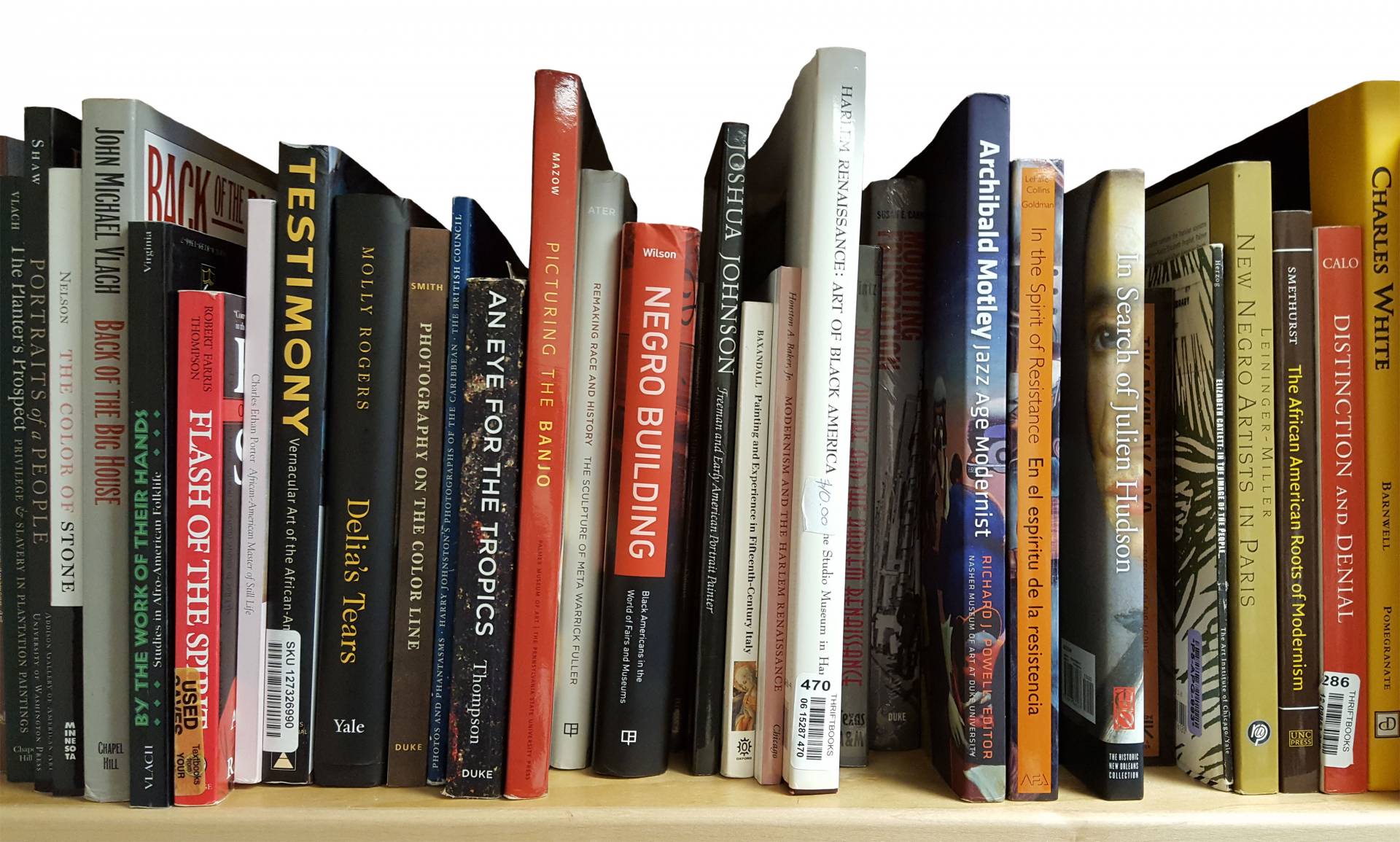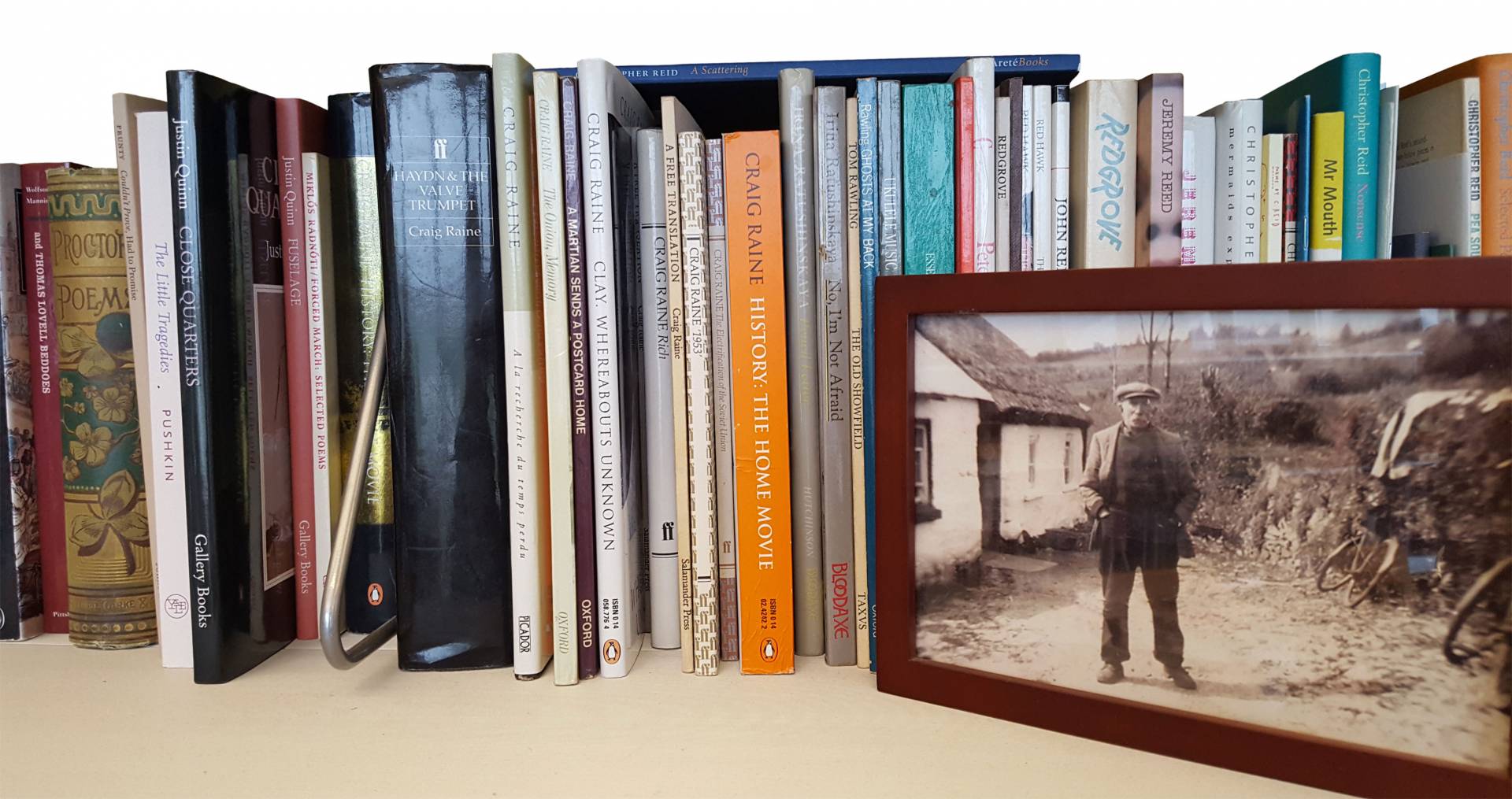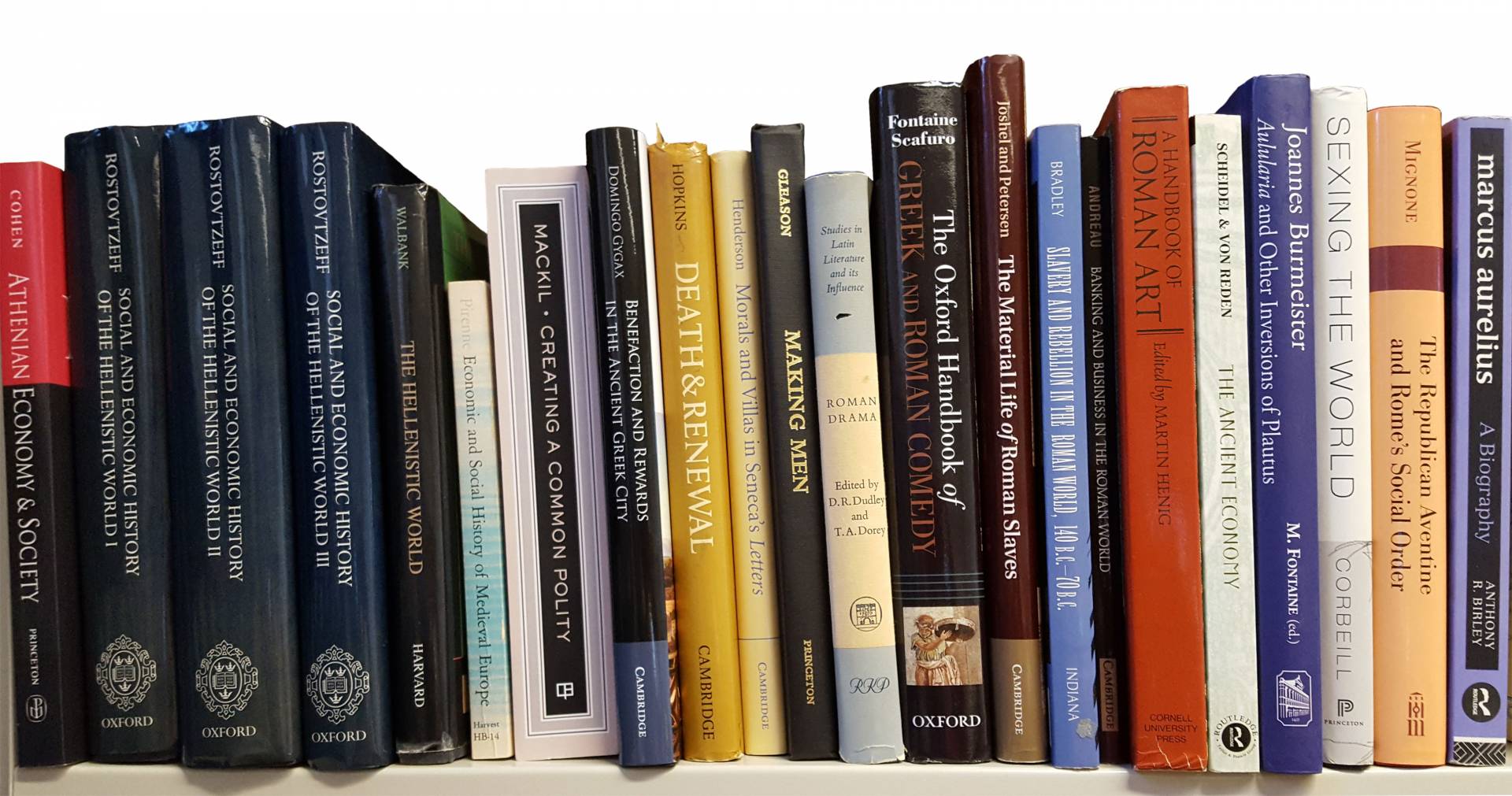Whether traveling with students on a summer course, serving on the judging panel of a book contest, researching a new book or simply putting their feet up, professors — like book lovers everywhere — think carefully about what to read each summer. Some relish the hunt through the shelves of used bookstores; others happily snap open their mobile device as their personal literary gateway. Their routes may differ, but the destination is the same: the distinct satisfaction of settling into a good book.
Below, six Princeton professors talk about how the books on their shelves relate to their work, highlight one or two favorite books and share what's on their own summer reading lists in our annual "Spinal tap" feature.
Editor's note: These musings were gathered during the academic year as University arts and humanities writer Jamie Saxon interviewed various professors for stories and projects for the University homepage and social media.


Anna Arabindan-Kesson, assistant professor of art and archaeology and African American studies
Anna Arabindan-Kesson
What are we looking at?
One book I'm crazy about on this shelf is Krista Thompson's "An Eye for the Tropics: Tourism, Photography and Framing the Caribbean Picturesque," which examines the ways historical forms of landscape representation helped to shape and define meanings of race, geography and nationhood in the Caribbean. It moves between the colonial period and the contemporary moment, and draws on an amazing range of visual sources. It's a book I have used as a model for the book I'm writing, "Black Bodies, White Gold: Art, Cotton and Commerce in the Atlantic World," which spans these time periods and similarly draws on a large visual archive. It also provides one of the best art histories of the British-speaking Caribbean and the ongoing significance of photography in framing our relationship to place, so I assign it in both my survey courses, "Black Diasporic Art" and "Art and Empire." It not only shows how and why photography (and other visual material) had a physical impact on the social and cultural landscape of Jamaica and the Bahamas, it is a great example of why art history matters and how it compels us to see the world differently.
What's on your summer reading list?
On my academic list: Walter Johnson, "River of Dark Dreams: Slavery and Empire in the Cotton Kingdom"; Sven Beckett, "An Empire of Cotton: A Global History"; Kellie Jones, "South of Pico: African American Artists in Los Angeles in the 1960s and 1970s"; Jennifer Raab, "Frederic Church: The Art and Science of Detail"; Charmaine Nelson, "Slavery, Geography and Empire in 19th-Century Marine Landscapes of Montreal and Jamaica"; Jasmine Nichole Cobb, "Picture Freedom: Remaking Black Visuality in the Early 19th Century"; Alessandra Raengo, "On The Sleeve of the Visual: Race as Face Value"; Christina Sharpe, "Monstrous Intimacies: Making Post-slavery Subjects"; Lisa Lowe, "The Intimacies of Four Contents"; Eddie Glaude Jr. [the William S. Tod Professor of Religion and African American Studies], "Exodus! Religion, Race, and Nation in Early Nineteenth-Century Black America"; and Allan Braddock et al., "A Keener Perception: Ecocritical Studies in American Art History."
On my personal list: Keeanga-Yamahhta Taylor [assistant professor of African American studies], "From #BlackLivesMatter to Black Liberation"; Colson Whitehead, "The Underground Railroad"; Marlon James, "The Book of Night Women"; Arundhati Roy, "The Ministry of Utmost Ruins"; Rajith Savanadasa, "Ruins"; Amitav Ghosh, "River of Smoke and Flood of Fire"; and Helen Garner, "Everywhere I Look."


Simon Morrison, professor of music
Simon Morrison
What are we looking at?
The three thick books on the shelf contain the correspondence between the composer Tchaikovsky and his patroness, Nadezhda von Mekk. I'll be depending on them for a revisionist study of the composer's career and works I'm writing, to be published by Yale University Press. I'm aiming in this book to de-subjectivize Tchaikovsky's music, to explain that he is not the suffering Romantic of musicological lore, but a civic-minded, imperial artist who moved in his career from neoclassicism to proto-surrealism.
This particular edition of Tchaikovsky's letters is uncensored and comes with superb annotations. It was assembled by Polina Vaydman, former director of the Tchaikovsky Museum-House in Klin (outside Moscow), and the foremost 20th- and early-21st-century expert on the composer. She died last year, a tremendous loss to the field. I am crazy about this book because the letters are fascinating, and the edition impeccable.
What's on your summer reading list?
I'm teaching a PIIRS Global Seminar for 15 Princeton students right now in Moscow (June 10-July 22), and my reading leading up to our departure was consumed with teaching prep. The seminar involves a mass of reading about the history, politics and culture of Moscow. The reading assignments included Symbolist poems, Afanasiev fairy tales, Tolstoy's fiction, historical chronicles from the Napoleonic era through to perestroika, political theses and recent journalism.
After Moscow, my personal summer reading list includes Olivia Laing's "The Lonely City" and Zadie Smith's "Swing Time."


Paul Muldoon, the Howard G.B. Clark '21 University Professor in the Humanities, professor of creative writing in the Lewis Center for the Arts and director of the Princeton Atelier
Paul Muldoon
What are we looking at?
That bit of shelf just happens to include books by two remarkable English poets, Craig Raine and Christopher Reid, who were known as the "Metaphor Men." Together, they reintroduced the outlandish metaphor as a way of forcing us to look again at the ordinary things of the world. I often use Raine's poem "A Martian Sends a Postcard Home" to encourage the outré in my students. To have them look again at the bicycle, say, which appears in that photograph on the shelf of my maternal grandfather, Frank Regan. The bicycle may be the only clue the photo was taken in the 1940s rather than the 1840s.
What's on your summer reading list?
My reading this summer includes a lot of rereading but the new books I've stacked against myself are mostly nonfiction. Two of those are "Killers of the Flower Moon: The Osage Murders and the Birth of the FBI" by David Grann and "The Rhinoceros and the Megatherium" by Juan Pimentel.


Dan-el Padilla Peralta, assistant professor of classics
Dan-el Padilla Peralta
What are we looking at?
Of the books on the shelf, the one I've been consulting most often is K. Hopkins' "Death and renewal: Sociological studies in Roman history vol. 2." For a very long time, I had only a PDF of this book to work from (#gradstudentlife #postdoclife); but last summer I finally purchased my own hard copy at the Strand, that marvelous bulwark against the Amazonification of the literate universe. Slipped into this hard copy was a cut-out of the Roman historian Michael Crawford’s 1984 review of the book in the Times Literary Supplement; it’s unexpected pleasures of this sort that keep me buying used books.
Together with its companion volume "Conquerors and Slaves," Hopkins' book represented a real watershed in the application of social-scientific methods to ancient history. I find myself channeling to my own students a famous bit of advice Hopkins once gave to his graduate students: "Be bold, bloody, and yourself." I'm not super-enthusiastic about that "bloody," but I'm happiest when I see my own students striving boldly to realize their full intersectional selves in their work, and I'm resolved to support them as they do so.
What's on your summer reading list?
On the academic front, I'm profiting immensely from Craige Champion’s newly published "The Peace of the Gods: Elite Religious Practices in the Middle Roman Republic." It's a great help as I go about clarifying and strengthening some of the arguments in my book-length manuscript on Roman republican religion (forthcoming from Princeton University Press). I'm now going back over Lorgia García-Peña's "The Borders of Dominicanidad" after having last month given it the good old speed read while I worked on an essay about Dominican receptions of ancient Greece and Rome for an edited volume; the book is simply mind-bending. Up to bat next, once thoughts and energies turn to preparing a unit on forms of servitude in ancient Near Eastern societies for my ancient slavery classes next year, will be Susan Pollock's "Ancient Mesopotamia"; Philippe Descola's "Beyond Nature and Culture," for a short article on ecology and divination that together with the book manuscript will nibble away at my summer serenity; and, if time allows, Ian Johnson's "The Souls of China: The Return of Religion after Mao."
At the top of my personal reading list is Edwidge Danticat's "Create Dangerously: The Immigrant Artist at Work," which I’ve been wanting to read for the proverbial hot minute. I've been on a graphic memoir kick ever since reading Alison Bechdel's "Fun Home" and volumes 1 and 2 of Riad Sattouf's "The Arab of the Future," so I can’t wait to begin reading Thi Bui's "The Best We Could Do." And why do I have to wait until February 2018 for volume 3 of Sattouf's memoir? I've committed to rereading Simone Weil’s "War and the Iliad" after a recent conversational effort to summon its contents back to memory drew a blank.


Martha Sandweiss, professor of history
Martha Sandweiss
What are we looking at?
I'm serving on an American Historical Association book prize committee this summer to select the best first or second book in American history published during the past two years. The books standing here, from my assigned section towards the end of the alphabet, are just a handful from the 140 books we received (the rest are in alphabetized rows on my closet floor!). The work can be onerous, but always holds unexpected surprises. Doing book prize duty in recent years, I've discovered wonderful books I would never have otherwise read — including Philip Shenon's "A Cruel and Shocking Act: The Secret History of the Kennedy Assassination" and Kate Brown's "Plutopia: Nuclear Families, Atomic Cities, and the Great Soviet and American Plutonium Disasters." I'm excited to see what emerges from the pile this summer.
What's on your summer reading list?
Later this summer, I'm making a research trip to the Pine Ridge reservation in South Dakota. Happily, for me, several extraordinary books about this community have just come out, and I'm now reading Louis Warren's "God's Red Son: The Ghost Dance Religion and the Making of Modern America," and Joe Jackson's new biography, "Black Elk: The Life of an American Visionary." Both of these books overturn long-held ideas about life on the northern Plains during the late 19th and early 20th centuries.
For whatever reason, I prefer to read history books in hard copy, but to devour fiction on my iPad. That iPad you see here is loaded with mysteries that I read at night (as if all the historical trauma I read about during the day is not enough). It also holds Toni Morrison's novels, which I plan to reread this summer. For several years now, I’ve been running the Princeton and Slavery Project, an investigation of the historical connections between our university and the American institution of slavery. To acknowledge the many ways we have to imagine the past, we're combining conventional historical approaches to the story with more creative ones. We're especially pleased that Morrison will be the keynote speaker at our big public symposium Nov. 17-18. Who better to address the ways that fiction can help us better understand historical events?


Susan Wolfson, professor of English
Susan Wolfson
What are we looking at?
This is not my "working library," which is at home, but rather my spillover and teaching-resource library, as well as a store of books to give to interested students (which I do a lot with duplicates). The books in my office in McCosh Hall are ones that I bring to class (especially the editions of Blake's illustrated poetry, from the Princeton University Press series), along with the framed portraits of the writers, not only to give an image but also an opportunity to discuss the styling of portraits, the image projected (and the one not projected).
My office library is living and mobile, changing from year to year as books arrive or depart, although some of these books are my historical artifacts, books I had as a graduate student, or from my first years of teaching. Also on these shelves are duplicates of books I've written, critical monographs, edited collections, edited anthologies, scholarly editions — so it's a display of what I do, too, and a way to show students about the life of a scholar, teacher, writer, editor, and the fertile interaction of these activities.
What's on your summer reading list?
This summer I'm finishing my latest critical monograph, "Romantic Shades and Shadows," about spectral imagination and its effects of reading and writing, and so I am reading and writing for that project. In between I'm reading Al Franken's "Giant of the Senate" and, sadly, "Shattered: Inside Hillary Clinton's Doomed Campaign" by Amie Parnes and Jonathan Allen. And just to get away from my political despair, I've got the recent book by Michael Wood [the Charles Barnwell Straut Class of 1923 Professor of English and Comparative Literature, Emeritus]. This is a superb little gem, "William Empson," about one of the 20th century's quirkiest, most incisive, most surprising readers of literature — Michael shares this spirit, and so there is a double pleasure.






